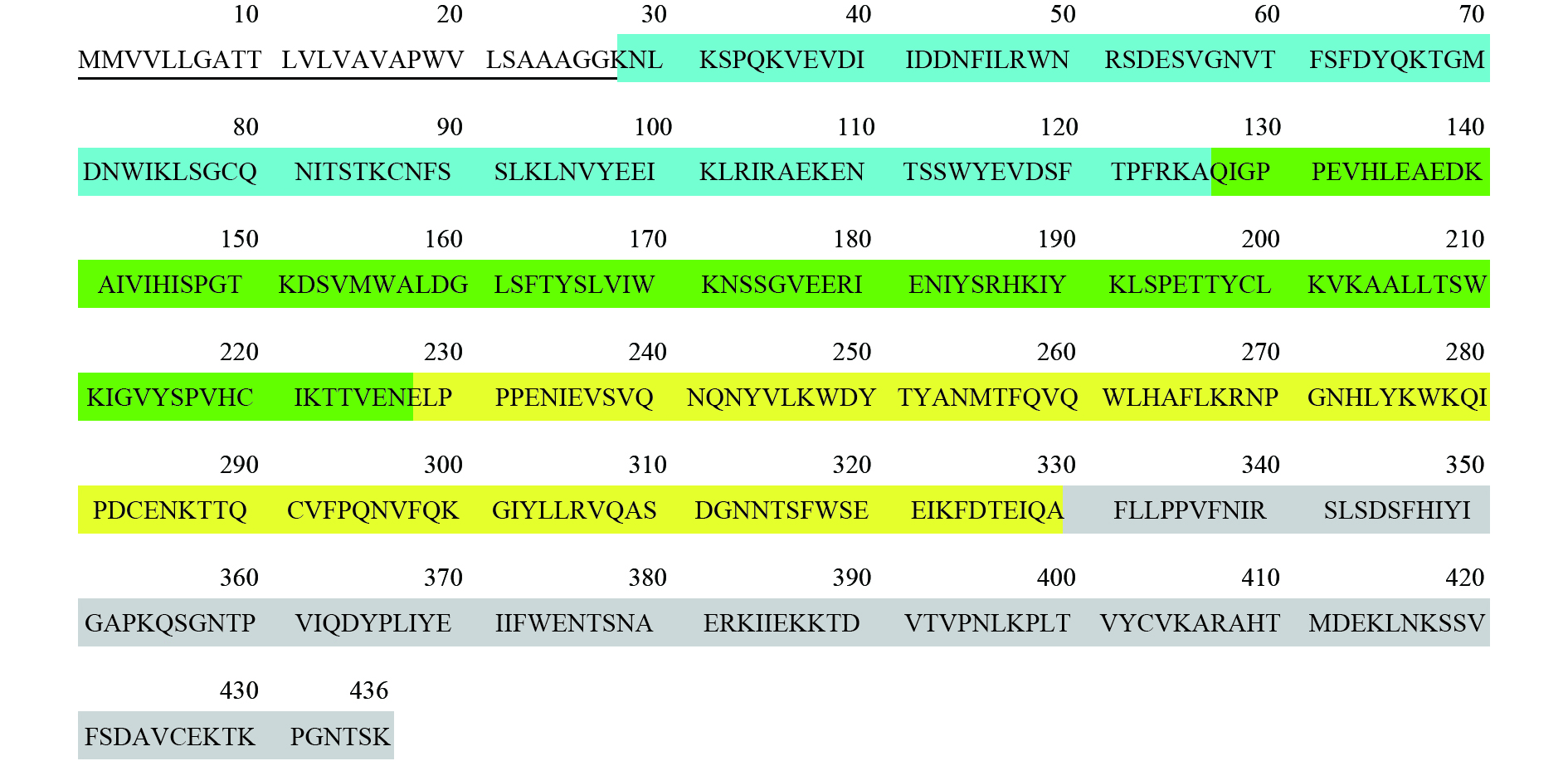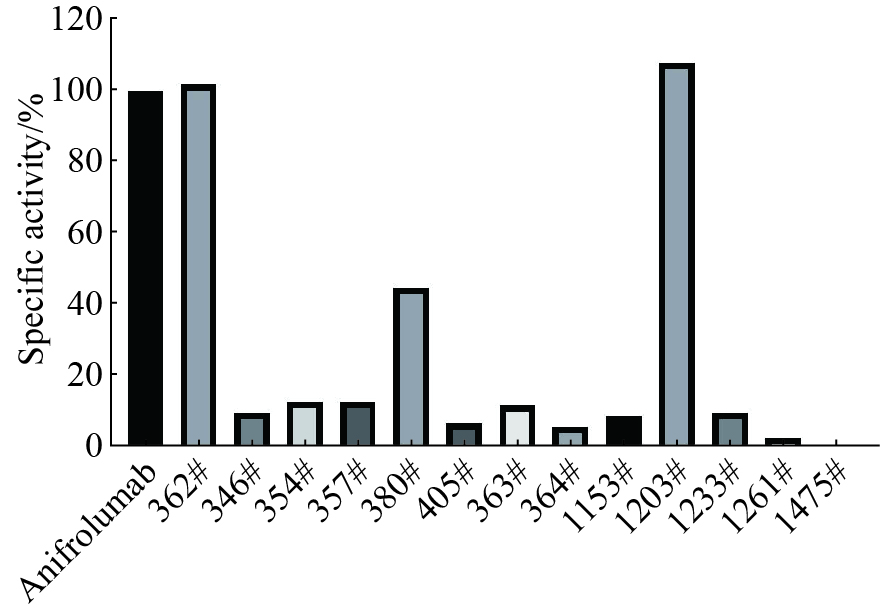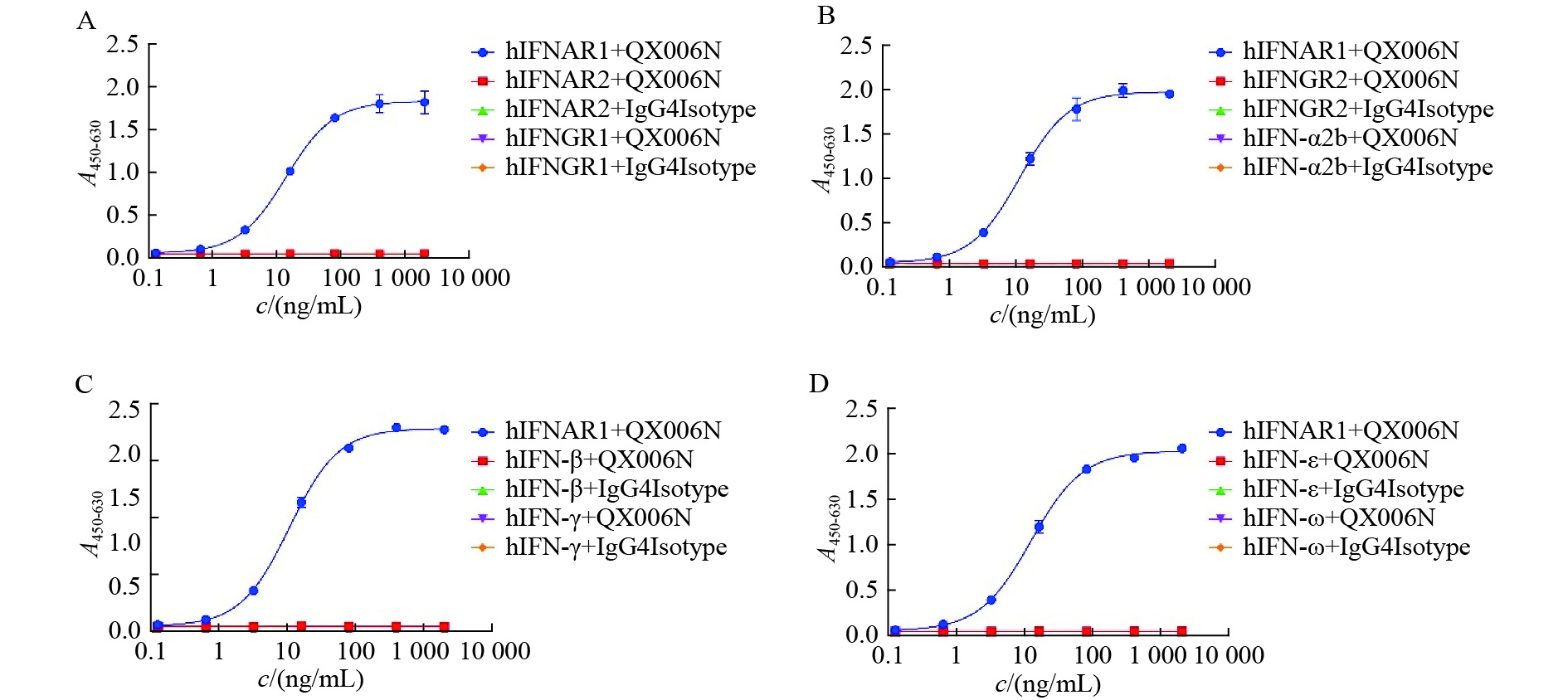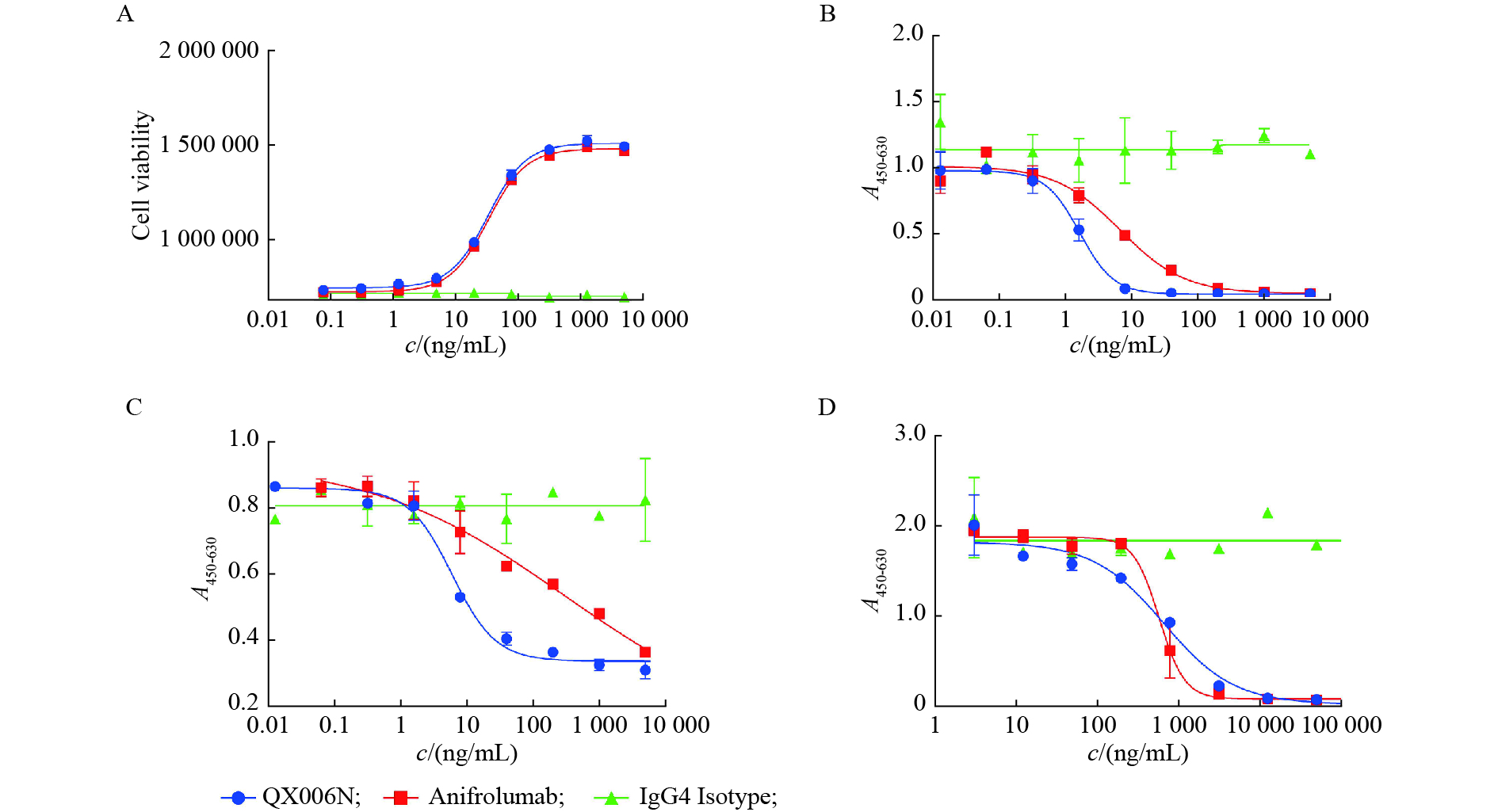Generation and characterization of humanized monoclonal antibody against human IFNAR1
-
摘要:
Ⅰ型干扰素在系统性红斑狼疮(SLE)等自身免疫性疾病的发病机制中发挥重要作用,采用抗体阻断其信号转导通路具有潜在的治疗作用。本研究以人Ⅰ型干扰素受体亚基1(IFNAR1)重组蛋白为抗原免疫新西兰白兔,采用B细胞克隆技术筛选兔抗人IFNAR1单克隆抗体,经过人源化改造获得QX006N。体外研究结果显示,QX006N能特异性地结合人IFNAR1,亲和力约108 pmol/L,可阻断Ⅰ型干扰素信号通路及其介导的生物学效应。本研究为开发靶向干预Ⅰ型干扰素信号途径用于治疗SLE的抗体药物提供了坚实的基础。
Abstract:Type I interferons play an important role in the pathogenesis of autoimmune diseases such as systemic lupus erythematosus (SLE). Monoclonal antibody shows therapeutic potential by blocking the signaling pathway. This study used recombinant human subunit 1 of the type I interferon receptor (IFNAR1) protein to immunize New Zealand white rabbits, and applied B cell cloning technology to screen and obtain rabbit parental antibodies. After humanization modification, QX006N was obtained. In vitro biological studies showed that QX006N could specifically bind to human IFNAR1 with an affinity of 108 pmol/L, and neutralize the type I interferon signaling pathway and this pathway mediated biological effects. This study provides a solid foundation for the development of antibody drugs targeting the type I interferon signaling pathway for the treatment of SLE.
-
-
Figure 3. Amino acid sequence alignment between the variable region of rabbit mAb 362# and 1203#
CDR region of the antibody is marked with an underscore according to the Kabat numbering scheme; “-” means the amino acid of 1203# is identical to 362#; VH:Heavy-chain variable region; VL:Light-chain variable region
Figure 4. Amino acid sequence alignment between the variable regions of humanized anti-IFNAR1 rabbit monoclonal antibodies
“-” denotes residues that are identical to human germline at the corresponding positions; “#” denotes the residues in human framework regions were back-mutated; “*” denotes the different residues between rabbit antibodies 362# and 1203#
Table 1 Different neutralization assays to evaluate the potency of QX006N
Assay Stimulating factor c/(ng/mL) Detection method HEK BlueTM
IFN-α/β cellIFN-α2b 0.05 STAT1/2 phosphorylation IFN-β 0.005 IFN-ω1 1 Daudi cell IFN-α2b 0.2 Cell proliferation THP-1 cell IFN-α2b 10 Release of IP-10 and BLyS Human whole blood cell IFN-α2b* 1 Release of IP-10 * with 5 ng/mL of TNFα
IP-10: Interferon gamma-induced protein 10; BLyS: B lymphocyte stimulator proteinTable 2 Neutralization activity of rabbit mAb 362# and 1203# based on HEK-BlueTM IFN-α/β reporter cells
Sample IC50/(ng/mL) IFN-α2b IFN-β IFN-ω1 Anifrolumab 5.5 28.3 23.3 362# 5.8 27.2 29.1 1203# 4.7 23.4 17.5 Table 3 Summary of humanized anti-IFNAR1 rabbit monoclonal antibodies
Antibody VH VL SEC-HPLC/% Activity ratio* Name Humanization Name Humanization HMW Monomer LMW HZD362-1 362VH-Hu1 97.7% 362VK-Hu1 100% 2.7 97.2 0.1 21.2% HZD362-5 362VH-Hu1 97.7% 362VK-Hu2 93.8% 1.2 98.8 ND 72.3% HZD1203-38 362VH-Hu6 97.7% 362VK-Hu13 98.8% 0.8 99.2 ND 35.0% HZD1203-39 362VH-Hu6 97.7% 362VK-Hu14 98.8% 0.8 99.2 ND 34.0% HZD1203-45 362VH-Hu6 97.7% 362VK-Hu20 97.5% 1.3 98.7 ND 92.0% ND:Not detected; HMW:High molecular weight; LMW:Low molecular weight
* Neutralization activity of humanized antibodies compared to anifrolumab was measured using HEK Blue™ IFN-α/β reporter cellTable 4 Affinity of QX006N and anifrolumab binding to human IFNAR1 ($ \bar{x} $± s, n = 3)
Sample ka/(×105 L∙mol-1∙s-1) kd/(×10-5/s) KD/(×10-10 mol/L) QX006N 3.47 3.76 1.08 Anifrolumab 18.67 12.40 0.67 Table 5 Neutralization activity of QX006N based on HEK Blue™ IFN-α/β cell ($ \bar{x} $± s, n = 3)
Sample IC50/(ng/mL) IFN-α2b IFN-β IFN-ω1 QX006N 4.6 ± 0.4 17.4 ± 1.2 12.1 ± 1.0 Anifrolumab 4.0 ± 0.2 17.4 ± 1.3 10.6 ± 0.7 IgG4 Isotype No neutralizing activity Table 6 Neutralization activity of QX006N based on Daudi, THP-1 and human whole blood cells ($ \bar{x} $±s, n = 3)
Sample IC50/(ng/mL) Daudi cells proliferation THP-1 cells IP-10 release THP-1 cells BLyS release Blood cells IP-10 release QX006N 31.4 ± 1.6 2.0 ± 0.5 5.9 ± 1.4 1003 ± 311 anifrolumab 31.3 ± 1.7 7.1 ± 0.8 101.3 ± 28.2 904 ± 314 IgG4 Isotype No neutralizing activity Table 7 QX006N binds to truncated hIFNAR1-ECD mutants
Sample QX006N EC50/(ng/mL) Ratio hIFNAR1-ECD 8.26 1.0 hIFNAR1(D1+D2) NA NA hIFNAR1(D3+D4) 4.29 0.5 hIFNAR1(D1+D2+D3) 8.53 1.0 NA: No binding -
[1] Ramaswamy M, Tummala R, Streicher K, et al. The pathogenesis, molecular mechanisms, and therapeutic potential of the interferon pathway in systemic lupus erythematosus and other autoimmune diseases[J]. Int J Mol Sci, 2021, 22(20): 11286. doi: 10.3390/ijms222011286
[2] Moll HP, Maier T, Zommer A, et al. The differential activity of interferon-α subtypes is consistent among distinct target genes and cell types[J]. Cytokine, 2011, 53(1): 52-59. doi: 10.1016/j.cyto.2010.09.006
[3] Peng L, Oganesyan V, Wu H, et al. Molecular basis for antagonistic activity of anifrolumab, an anti-interferon-α receptor 1 antibody[J]. MAbs, 2015, 7(2): 428-439. doi: 10.1080/19420862.2015.1007810
[4] González-Navajas JM, Lee J, David M, et al. Immunomodulatory functions of type I interferons[J]. Nat Rev Immunol, 2012, 12(2): 125-135. doi: 10.1038/nri3133
[5] Jiang J, Zhao M, Chang C, et al. Type I interferons in the pathogenesis and treatment of autoimmune diseases[J]. Clin Rev Allergy Immunol, 2020, 59(2): 248-272. doi: 10.1007/s12016-020-08798-2
[6] Rönnblom L, Leonard D. Interferon pathway in SLE: one key to unlocking the mystery of the disease[J]. Lupus Sci Med, 2019, 6(1): e000270. doi: 10.1136/lupus-2018-000270
[7] Crow MK, Olferiev M, Kirou KA. Type I interferons in autoimmune disease[J]. Annu Rev Pathol, 2019, 14: 369-393. doi: 10.1146/annurev-pathol-020117-043952
[8] Kalunian KC, Merrill JT, Maciuca R, et al. A Phase II study of the efficacy and safety of rontalizumab (rhuMAb interferon-α) in patients with systemic lupus erythematosus (ROSE)[J]. Ann Rheum Dis, 2016, 75(1): 196-202. doi: 10.1136/annrheumdis-2014-206090
[9] Anderson E, Furie R. Anifrolumab in systemic lupus erythematosus: current knowledge and future considerations[J]. Immunotherapy, 2020, 12(5): 275-286. doi: 10.2217/imt-2020-0017
[10] Khamashta M, Merrill JT, Werth VP, et al. Sifalimumab, an anti-interferon-α monoclonal antibody, in moderate to severe systemic lupus erythematosus: a randomised, double-blind, placebo-controlled study[J]. Ann Rheum Dis, 2016, 75(11): 1909-1916. doi: 10.1136/annrheumdis-2015-208562
[11] Kaplon H, Chenoweth A, Crescioli S, et al. Antibodies to watch in 2022[J]. MAbs, 2022, 14(1): 2014296. doi: 10.1080/19420862.2021.2014296
[12] Deeks ED. Anifrolumab: first approval[J]. Drugs, 2021, 81(15): 1795-1802. doi: 10.1007/s40265-021-01604-z
[13] Piehler J, Thomas C, Garcia KC, et al. Structural and dynamic determinants of type I interferon receptor assembly and their functional interpretation[J]. Immunol Rev, 2012, 250(1): 317-334. doi: 10.1111/imr.12001
[14] Weber J, Peng HY, Rader C. From rabbit antibody repertoires to rabbit monoclonal antibodies[J]. Exp Mol Med, 2017, 49(3): e305. doi: 10.1038/emm.2017.23
[15] Markham A. Brolucizumab: first approval[J]. Drugs, 2019, 79(18): 1997-2000. doi: 10.1007/s40265-019-01231-9
[16] Dhillon S. Eptinezumab: first approval[J]. Drugs, 2020, 80(7): 733-739. doi: 10.1007/s40265-020-01300-4
-
期刊类型引用(0)
其他类型引用(1)




 下载:
下载:







